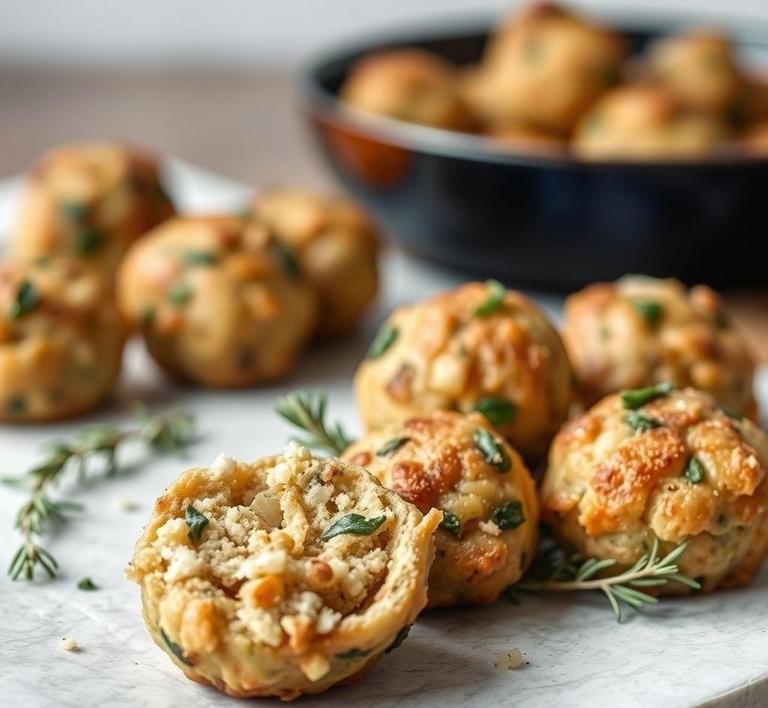Mary Berry’s Sage and Onion Stuffing Balls are a quintessential British classic, embodying the warmth and nostalgia of festive dinners, Sunday roasts, and family gatherings. These little golden spheres of flavor are essentially bite-sized portions of traditional stuffing, enriched with fragrant sage and sweet onions, shaped into neat balls, and then baked to perfection.
Stuffing itself is a beloved accompaniment to roasted meats, especially turkey or chicken, acting as a flavorful, moist contrast to the crispy skin and tender flesh. What makes Mary Berry’s version stand out is her signature balance of simplicity and flavor. The sage offers a herbaceous, slightly peppery note that perfectly complements the caramelized onions’ subtle sweetness. The texture is soft on the inside with a lightly crisp exterior, creating a wonderful mouthfeel.
These stuffing balls can be served alongside your roast as an accompaniment, but they’re also fantastic as appetizers or part of a festive buffet. They encapsulate all the comfort and tradition of British holiday cooking but in a fun, convenient form.
Mary Berry’s Sage And Onion Stuffing Balls Recipe
Ingredients Needed

To create these beautiful Sage and Onion Stuffing Balls, you’ll want to gather a handful of fresh, wholesome ingredients. Mary Berry’s recipe is known for its straightforwardness, relying on quality basics that harmonize wonderfully:
- White bread: Preferably slightly stale or dried out, as it soaks up moisture without becoming too soggy. You’ll need the bread to be cubed or broken up finely.
- Onions: Finely chopped and gently sautéed until soft and translucent to bring out their natural sweetness.
- Fresh sage leaves: Finely chopped for that distinct aromatic touch that defines this stuffing.
- Butter: For frying the onions and adding richness to the mixture.
- Stock or broth: Usually chicken or vegetable, to moisten the bread crumbs and bind the mixture.
- Eggs: Lightly beaten, to help bind the stuffing balls and give them structure.
- Salt and pepper: To season perfectly, balancing the flavors.
- Optional additions: Sometimes, Mary Berry’s recipe may include a touch of garlic, or a pinch of nutmeg for warmth, but the classic sage and onion combo is what shines here.
The beauty of this recipe is how these humble ingredients come together to create something far greater than the sum of its parts.
Equipment Needed
While Mary Berry’s recipes often emphasize accessibility, a few key pieces of equipment will help you achieve the perfect Sage and Onion Stuffing Balls:
- Large frying pan or skillet: To gently sauté the onions in butter, coaxing out their sweetness without browning too much.
- Mixing bowl: For combining all your ingredients thoroughly.
- Wooden spoon or spatula: For stirring the mixture.
- Baking tray or sheet: Lined with parchment paper or lightly greased, for placing your stuffing balls before they go into the oven.
- Measuring cups and spoons: To keep the ingredient ratios precise.
- Knife and chopping board: For finely chopping onions and sage.
- Oven: Preheated to the right temperature for baking your stuffing balls until golden and delicious.
- Optional: A small ice cream scoop or spoon can help shape uniform stuffing balls easily.
This setup is quite straightforward and likely already present in most kitchens, making this recipe very approachable.
Instructions To Make Mary Berry’s Sage And Onion Stuffing Balls
Now, here’s where the magic happens. Follow these detailed steps to bring Mary Berry’s Sage and Onion Stuffing Balls to life:
- Prepare the bread: Start with your white bread slices-cut off the crusts if you prefer a softer texture-and break or tear into small pieces. You want about 200g (7 oz) of bread crumbs. If your bread isn’t stale, lightly toast it in the oven to dry it out.
- Sauté the onions: Melt 50g (about 3.5 tbsp) of butter in a large frying pan over a gentle heat. Add 2 finely chopped onions and cook slowly, stirring occasionally until soft and translucent, roughly 8-10 minutes. Avoid browning them too much; the goal is to release sweetness.
- Add the sage: Toss in 1 tablespoon of finely chopped fresh sage leaves to the onions and stir for a minute to release the aromatic oils.
- Combine ingredients: Transfer the onions and sage into a large mixing bowl with the breadcrumbs. Add 150ml (about 2/3 cup) of hot chicken or vegetable stock slowly while stirring, until the mixture is moist but not soggy.
- Bind the mixture: Beat 1 large egg and add it to the stuffing mixture. Season with salt and freshly ground black pepper. Mix everything thoroughly; the egg will help the mixture hold its shape.
- Shape the balls: Take handful-sized portions of the mixture and gently roll them between your palms into neat balls about the size of a walnut or golf ball.
- Bake: Place the stuffing balls on a baking tray lined with parchment paper. Bake in a preheated oven at 190°C (375°F) for 20-25 minutes or until they are golden brown and firm to the touch.
- Serve: Let the balls cool slightly before serving. They are fantastic hot alongside your roast, or even cold as part of a picnic or buffet.
Tips And Tricks
- Bread texture matters: Stale bread is your best friend here, as it absorbs the stock without collapsing. If fresh bread is all you have, lightly toast it before using.
- Don’t rush the onions: Sauté slowly and patiently; this builds the base flavor.
- Moisture balance is key: Adding stock gradually helps you avoid a too-wet mixture that won’t hold shape or a dry mix that’s crumbly.
- Shape gently: Press the mixture just enough to form balls without compacting too much; this keeps them light inside.
- Experiment with herbs: While sage is classic, a touch of thyme or parsley can add interesting layers.
- Make ahead: Stuffing balls can be made a day ahead and refrigerated; just reheat in the oven before serving.
- Freeze for later: These balls freeze beautifully. Freeze on a tray first, then transfer to a bag to store. Bake straight from frozen, adding a few extra minutes to cooking time.
Mary Berry’s Sage and Onion Stuffing Balls capture the heart and soul of traditional British cooking in an irresistibly simple yet flavorful dish. These golden orbs of herbed bread, softened with stock and enriched with buttery onions and fragrant sage, are not only the perfect accompaniment to a roast but also a charming, crowd-pleasing snack or starter.
They remind us that comfort food doesn’t need to be complicated-just crafted with care, good ingredients, and a bit of love. Whether you’re looking to impress at a festive dinner, add a classic touch to your Sunday roast, or simply enjoy a savory treat, these stuffing balls are a fantastic choice. Give Mary Berry’s recipe a go, and you’ll soon see why it remains a cherished staple in kitchens across the UK and beyond.
Easy Recipe Variations For Mary Berry’s Sage And Onion Stuffing Balls

Mary Berry’s classic sage and onion stuffing balls are a staple in British kitchens, cherished for their perfect balance of aromatic herbs, soft onions, and that comforting bread base. But what makes this recipe truly special is its versatility. Once you’ve mastered the basic stuffing ball, the possibilities for variations are endless, allowing you to tailor the dish to different tastes, dietary preferences, or occasions.
1. Add a Cheesy Twist:
For a richer, indulgent flavor, try mixing in a handful of grated cheddar, Parmesan, or even a crumbled blue cheese. Cheese adds a lovely gooey texture inside the balls and enhances the savory depth, turning a humble side into a crowd-pleaser. Just fold the cheese into the mixture before shaping your balls.
2. Incorporate Nuts and Seeds:
Adding toasted pine nuts, walnuts, or pecans can bring a delightful crunch and a nutty dimension to your stuffing balls. Toast them lightly to bring out their oils and flavor, then fold them in gently. Seeds like pumpkin or sunflower seeds also work well for extra texture and nutrition.
3. Boost the Herb Game:
While sage and onion are the stars, experimenting with other fresh herbs like thyme, rosemary, parsley, or chives can transform the stuffing balls. These herbs can complement or replace sage for a subtly different aroma and taste. For example, rosemary lends a piney, slightly citrusy note that pairs beautifully with roast meats.
4. Go Vegetarian or Vegan:
Mary Berry’s recipe can be adapted to suit vegetarian or vegan diets by using vegetable stock instead of chicken stock and replacing butter with plant-based margarine or oils. Adding finely chopped mushrooms or cooked chestnuts into the mix can lend extra umami flavor and a pleasant earthy richness.
5. Spice It Up:
For those who like a little heat, incorporating a pinch of chili flakes, smoked paprika, or ground black pepper can give a warming kick. You could also try a hint of garlic powder or even curry powder for a subtly exotic twist.
6. Use Different Breads:
Instead of traditional white bread, try using rustic sourdough, wholemeal, or even cornbread crumbs. Each will affect the texture and flavor differently – sourdough adds tanginess, wholemeal gives nuttiness and a heartier feel, and cornbread adds a sweet, crumbly contrast.
7. Add Fruit:
Dried fruits like cranberries, apricots, or raisins introduce a sweet balance to the savory stuffing. This combination is especially lovely during the holiday season when you want stuffing balls that feel festive and a little luxurious.
These variations are easy to experiment with and can be adjusted based on what you have in the pantry or the theme of your meal. The key is to maintain the moist, tender texture Mary Berry’s original recipe is famous for, while exploring flavors that excite your palate.
Storing Leftovers
One of the joys of Mary Berry’s sage and onion stuffing balls is how well they keep, making them perfect for cooking ahead or enjoying the next day. Proper storage not only preserves their taste but also maintains the delicate texture and prevents them from drying out or turning soggy.
Refrigeration:
If you have leftover stuffing balls, let them cool completely to room temperature before storing. Place them in an airtight container to avoid moisture buildup and refrigerate. Stored this way, they’ll keep well for up to 3-4 days. When you’re ready to eat, reheat gently in the oven at a low temperature (around 150-160°C or 300°F) to warm through without drying out. Wrapping them in foil can help retain moisture during reheating.
Freezing:
Stuffing balls freeze brilliantly. To freeze, lay them out on a baking sheet so they’re not touching, and pop them in the freezer until solid (this prevents them sticking together). Once frozen, transfer them to a freezer-safe bag or container. They’ll keep well for up to 3 months. When you want to eat them, bake from frozen, adding a few extra minutes to the cooking time, or thaw overnight in the fridge and reheat in the oven.
Tips For Best Results
- Avoid microwaving leftovers as it tends to make the balls rubbery or soggy.
- If you want to refresh the crispy outer texture after reheating, finish the last few minutes under the grill but watch closely to prevent burning.
- If stuffing balls have absorbed too much moisture, sprinkle a little dry breadcrumbs over them before reheating to help restore some crunch.
Storing and reheating properly means you can enjoy the delicious flavors and textures of Mary Berry’s sage and onion stuffing balls long after the initial cooking session.
What To Eat With Mary Berry’s Sage And Onion Stuffing Balls?
Stuffing balls are wonderfully versatile, and Mary Berry’s sage and onion version is no exception. Their warm, herbaceous flavor and soft, yet slightly crisp texture make them a perfect accompaniment for a wide range of dishes-especially during festive meals, Sunday roasts, or comforting family dinners.
1. Traditional Roast Dinner:
The most classic pairing is with a roast-whether it’s roast turkey, chicken, pork, or beef. The stuffing balls soak up the roasting juices beautifully and add a herbaceous lift to each bite. Accompany them with roasted potatoes, glazed carrots, Brussels sprouts, and a rich gravy for the ultimate British feast.
2. Vegetarian or Vegan Roasts:
If you’re serving a vegetarian main like a nut roast, stuffed squash, or a mushroom Wellington, these stuffing balls add that familiar savory note and texture contrast. Pair with roasted root vegetables, mashed potatoes, and cranberry sauce for a hearty meal.
3. Soups and Stews:
Stuffing balls can act as a delightful side or even an accompaniment to thick, warming soups or stews. Imagine them served alongside a creamy pumpkin soup, hearty lentil stew, or classic beef casserole. Their crumbly, moist interior complements smooth and rich liquids perfectly.
4. Salads and Light Meals:
For a lighter take, serve smaller stuffing balls with a crisp green salad dressed in a tangy vinaigrette. This can work well as a lunch option or a starter, bringing a balance between fresh, crunchy vegetables and the soft, savory balls.
5. Festive Buffets or Party Platters:
Because they’re bite-sized and easy to eat, stuffing balls make excellent finger food at parties or buffets. Present them with a variety of dips-cranberry sauce, mustard mayonnaise, or a spiced tomato chutney-for guests to enjoy as savory nibbles.
6. Breakfast or Brunch:
Why not get creative? Serve small stuffing balls alongside scrambled eggs, sautéed mushrooms, and grilled tomatoes for a British-inspired brunch. Their savory, herbaceous notes add complexity and a satisfying bite to your morning spread.
No matter how you serve them, Mary Berry’s sage and onion stuffing balls bring comforting flavors and textures that elevate every meal they join.
Conclusion
Mary Berry’s sage and onion stuffing balls are a timeless culinary delight-simple, comforting, and utterly versatile. Whether you stick to the classic recipe or experiment with cheeses, nuts, herbs, or spices, these stuffing balls hold a special place on any dining table. They pair wonderfully with a variety of dishes, from traditional roasts to vibrant salads and even festive spreads.
The joy of this recipe also lies in its practicality: easy to make, wonderful to store, and delicious reheated, they help bring warmth and flavor to meals long after the initial cooking. With their perfect blend of sage, onion, and breadcrumb goodness, these stuffing balls capture the essence of home cooking-a dish that is as heartwarming as it is satisfying.
So next time you’re planning a meal, consider whipping up a batch of Mary Berry’s sage and onion stuffing balls. They’re sure to become a beloved favorite, delighting your family and guests with their comforting, aromatic charm.
FAQs
What Are The Key Ingredients In Mary Berry’s Sage And Onion Stuffing Balls?
Mary Berry’s sage and onion stuffing balls are made with a simple combination of white bread, onions, fresh sage, butter, and stock. The recipe also includes eggs to bind the ingredients together and seasoning for flavor. The stuffing balls are baked until golden and crispy, providing a deliciously aromatic side dish for any roast meal.
Can I Make Mary Berry’s Sage And Onion Stuffing Balls In Advance?
Yes, you can prepare Mary Berry’s sage and onion stuffing balls ahead of time. After shaping the stuffing balls, place them on a baking tray and refrigerate them for up to 24 hours. When you’re ready to bake them, simply cook them from the fridge, adding a few extra minutes to the baking time to ensure they are fully heated through and golden.
How Can I Make Mary Berry’s Sage And Onion Stuffing Balls Vegetarian Or Gluten-free?
To make Mary Berry’s sage and onion stuffing balls vegetarian, simply ensure that the stock used is vegetable-based rather than chicken. For a gluten-free version, swap the regular bread for gluten-free bread and check that the stock and any additional ingredients are certified gluten-free. You may also want to adjust the seasoning to taste, as gluten-free bread can sometimes alter the flavor slightly.


